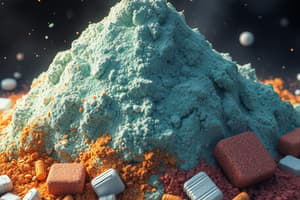Podcast
Questions and Answers
What is levigation used for in pharmaceutical formulation?
What is levigation used for in pharmaceutical formulation?
- Incorporating liquids into powders
- Reducing particle size
- Incorporating medicinal agents into fatty bases (correct)
- Blending powders
Which of the following is a characteristic of properly prepared powders?
Which of the following is a characteristic of properly prepared powders?
- Uniform particle size (correct)
- Large particle size
- Unstable storage requirements
- Slow absorption rate
What is the purpose of effervescent salts in pharmaceuticals?
What is the purpose of effervescent salts in pharmaceuticals?
- To initiate effervescence prior to ingestion (correct)
- To adhere to the skin
- To reduce particle size
- To increase storage stability
Flashcards are hidden until you start studying
Study Notes
Powders in Pharmaceutical Formulation
-
Powders are a solid or mixture of solids that are finely divided for internal or external use.
-
Properly prepared powders have a uniform, small particle size that is rapidly soluble and quickly absorbed.
-
Powders have a large surface area that can be reactive and require tight containers for storage.
-
Topical powders require a uniform, small particle size that adheres to the skin and does not irritate it.
-
Insufflated powders are finely divided powders intended for application in body cavities.
-
Before using powders in pharmaceuticals, solid materials must be characterized to determine their chemical and physical features.
-
The United States Pharmacopeia uses descriptive terms to characterize particle size, including very coarse, coarse, moderately coarse, fine, and very fine.
-
Powders are comminuted or ground to reduce their particle size, and levigation is used for medicinal agents incorporated into fatty bases.
-
Powder blending can be achieved through spatulation, trituration, sifting, and tumbling.
-
Medicated powders can be used internally or externally and are available in bulk or divided dosages.
-
Some powders are administered by inhalation or dry powder inhalers for the treatment of bronchial disorders.
-
Compounding pharmacists must address problems associated with eutectics, hygroscopic and deliquescent powders, and efflorescent powders.Methods for Formulating Granules and Effervescent Salts
-
Anhydrous salt form of a drug or a drying bulky powder can be used to liquefy a drug.
-
Certain powder combinations like bromine & alcohol, chlorates & bisulfites, and chloric acid & bromides can react violently when mixed together.
-
Liquids can be incorporated into dry powder by adsorbing onto an inert material or by mixing it with increasing quantities of the powder.
-
Granules are a dosage form composed of dry aggregates of powder particles that may contain one or more APIs, with or without other ingredients.
-
Granules can be swallowed as such, dispersed in food, or dissolved in water and are frequently compacted into tablets or filled into capsules.
-
Granules are prepared agglomerates of smaller particles of powder and are usually in the 4- to 12-mesh sieve size range.
-
Granules can be prepared by wet methods and dry methods, including moistening the powder mixture and passing it through a screen of the mesh size.
-
Granules flow better compared to powders and are more stable to the effects of atmospheric humidity and are less likely to cake or harden.
-
Effervescent dosage forms contain ingredients that, when in contact with water, rapidly release carbon dioxide and are dissolved or dispersed in water to initiate the effervescence prior to ingestion.
-
Effervescent salts are granules or coarse to very coarse powders containing a medicinal agent in a dry mixture usually composed of sodium bicarbonate, citric acid, and tartaric acid.
-
Effervescent granules can be prepared by two general methods: the dry or fusion method and the wet method.
-
In the fusion method, the one molecule of water present in each molecule of citric acid acts as the binding agent for the powder mixture, and in the wet method, alcohol is used as the moistening agent.
Studying That Suits You
Use AI to generate personalized quizzes and flashcards to suit your learning preferences.




